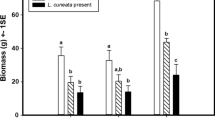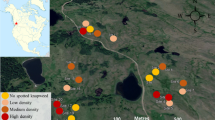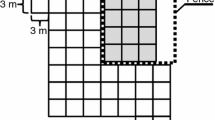Abstract
Predation pressure and resource availability often interact in structuring herbivore communities, with their relative influence varying in space and time. The operation of multiple ecological pressures and guild-specific herbivore responses may combine to override simple predictions of how the roles of plant quality and predation pressure vary in space. For 2 years at the Coweeta LTER in the Southern Appalachian Mountains, we conducted a bird exclosure experiment on red oak (Quercus rubra) saplings to investigate the effects of bird predation on red oak arthropod communities. We established bird exclosures at six sites along an elevational gradient and estimated variation in foliar nitrogen and bird predation pressure along this gradient. Foliar nitrogen concentrations increased with elevation while our index of bird predation pressure was variable across sites. Greater arthropod densities were detected inside exclosures; however, this result was mainly driven by the response of phloem feeders which were much more prevalent inside exclosures than on control trees. There was little evidence for an effect of bird predation on the other arthropod guilds. Consequently, there was no evidence of a trophic cascade either in terms of leaf damage or tree growth. Finally, we found more variation in arthropod density among trees within sites than variation in arthropod density among sites, indicating the importance of micro-site variation in structuring arthropod communities.




Similar content being viewed by others
References
Barber NA, Marquis RJ (2009) Spatial variation in top-down direct and indirect effects on white oak (Quercus alba L.). American Midland Naturalist 162:169–179
Bock CE, Bock JH, Grant MC (1992) Effects of bird predation on grasshopper densities in an Arizona grassland. Ecology 73:1706–1717
Borer ET et al (2005) What determines the strength of a trophic cascade? Ecology 86:528–537
Burnham KP, Anderson DR (2002) Model selection and multi-model inference: a practical information-theoretic approach, 2nd edn. Springer, New York
Chase JM (2003) Strong and weak trophic cascades along a productivity gradient. Oikos 101:187–195
Chase JM, Leibold MA, Downing AL, Shurin JB (2000) The effects of productivity, herbivory, and plant species turnover in grassland food webs. Ecology 81:2485–2497
Cornelissen T, Stiling P (2006) Responses of different herbivore guilds to nutrient addition and natural enemy exclusion. Ecoscience 13:66–74
Cornell HV, Hawkins BA (1995) Survival patterns and mortality sources of herbivorous insects—some demographic trends. Am Nat 145:563–593
Denno RF, Gratton C, Peterson MA, Langellotto GA, Finke DL, Huberty AF (2002) Bottom-up forces mediate natural-enemy impact in a phytophagous insect community. Ecology 83:1443–1458
Denno RF et al (2000) Feeding-induced changes in plant quality mediate interspecific competition between sap-feeding herbivores. Ecology 81:1814–1827
Finke DL, Denno RF (2002) Intraguild predation diminished in complex-structured vegetation: implications for prey suppression. Ecology 83:643–652
Forkner RE, Hunter MD (2000) What goes up must come down? Nutrient addition and predation pressure on oak herbivores. Ecology 81:1588–1600
Greenberg R (1995) Insectivorous migratory birds in tropical ecosystems—the breeding currency hypothesis. J Avian Biol 26:260–264
Gripenberg S, Roslin T (2007) Up or down in space? Uniting the bottom-up versus top-down paradigm and spatial ecology. Oikos 116:181–188
Gruner DS (2004) Attenuation of top-down and bottom-up forces in a complex terrestrial community. Ecology 85:3010–3022
Gunnarsson B (2007) Predation on spiders: Ecological mechanisms and evolutionary consequences. J Arachnol 35:509–529
Hawkins BA, Cornell HV, Hochberg ME (1997) Predators, parasitoids, and pathogens as mortality agents in phytophagous insect populations. Ecology 78:2145–2152
Huberty AF, Denno RF (2006) Consequences of nitrogen and phosphorus limitation for the performance of two planthoppers with divergent life-history strategies. Oecologia 149:444–455
Hunter MD (1987) Opposing effects of spring defoliation on late season oak caterpillars. Ecol Entomol 12:373–382
Hunter MD (1990) Differential susceptibility to variable plant phenology and its role in competition between two insect herbivores on oak. Ecol Entomol 15:401–408
Hunter MD (2001) Multiple approaches to estimating the relative importance of top-down and bottom-up forces on insect populations: experiments, life tables, and time-series analysis. Basic Appl Ecol 2:295–309
Hunter MD (2009) Trophic promiscuity, intraguild predation, and the problem of omnivores. Agric For Entomol 11:125–131
Hunter MD, Price PW (1992) Playing chutes and ladders—heterogeneity and the relative roles of bottom-up and top-down forces in natural communities. Ecology 73:724–732
Hunter MD, Schultz JC (1995) Fertilization mitigates chemical induction and herbivore responses within damaged oak trees. Ecology 76:1226–1232
Knoepp JD, Swank WT (1998) Rates of nitrogen mineralization across an elevation and vegetation gradient in the southern Appalachians. Plant Soil 204:235–241
Lichtenberg JS, Lichtenberg DA (2002) Weak trophic interactions among birds, insects and white oak saplings (Quercus alba). Am Midl Nat 148:338–349
Lill JT, Marquis RJ (2001) The effects of leaf quality on herbivore performance and attack from natural enemies. Oecologia 126:418–428
Marquis RJ, Lill JT, Piccinni A (2002) Effect of plant architecture on colonization and damage by leaftying caterpillars of Quercus alba. Oikos 99:531–537
Marquis RJ, Whelan CJ (1994) Insectivorous birds increase growth of white oak through consumption of leaf-chewing insects. Ecology 75:2007–2014
Mols CMM, Visser ME (2002) Great tits can reduce caterpillar damage in apple orchards. J Appl Ecol 39:888–899
Mooney KA, Gruner DS, Barber NA, Van Bael SA, Philpott SM, Greenberg R (2010) Interactions among predators and the cascading effects of vertebrate insectivores on arthropod communities and plants. Proc Natl Acad Sci USA 107:7335–7340
Mooney KA, Linhart YB (2006) Contrasting cascades: insectivorous birds increase pine but not parasitic mistletoe growth. J Anim Ecol 75:350–357
Moreau G, Eveleigh ES, Lucarotti CJ, Quiring DT (2006) Ecosystem alteration modifies the relative strengths of bottom-up and top-down forces in a herbivore population. J Anim Ecol 75:853–861
Muller C, Brakefield PM (2003) Analysis of a chemical defense in sawfly larvae: Easy bleeding targets predatory wasps in late summer. J Chem Ecol 29:2683–2694
Murdoch WW, Swarbrick SL, Briggs CJ (2006) Biological control: lessons from a study of California red scale. Popul Ecol 48:297–305
Oksanen L, Fretwell SD, Arruda J, Niemela P (1981) Exploitation Ecosystems in Gradients of Primary Productivity. Am Nat 118:240–261
Polis GA, Strong DR (1996) Food web complexity and community dynamics. Am Nat 147:813–846
Power ME (1992) Top-down and bottom-up forces in food webs—do plants have primacy. Ecology 73:733–746
Preszler RW, Boecklen WJ (1996) The influence of elevation on tri-trophic interactions: Opposing gradients of top-down and bottom-up effects on a leaf-mining moth. Ecoscience 3:75–80
Richards LA, Coley PD (2007) Seasonal and habitat differences affect the impact of food and predation on herbivores: a comparison between gaps and understory of a tropical forest. Oikos 116:31–40
Ritchie ME (2000) Nitrogen limitation and trophic vs. abiotic influences on insect herbivores in a temperate grassland. Ecology 81:1601–1612
Rossiter M (1988) Relationships among defoliation, red oak phenolics, and gypsy moth growth and reproduction. Ecology 69:267–277
SAS Institute (2006) SAS 9.1.3 Help and documentation. SAS Institute, Cary, North Carolina
Singer JD (1998) Using SAS PROC MIXED to fit multilevel models, hierarchical models, and individual growth models. J Educ Behav Stat 23:323–355
Sipura M (1999) Tritrophic interactions: willows, herbivorous insects and insectivorous birds. Oecologia 121:537–545
Stiling P, Moon DC (2005) Quality or quantity: the direct and indirect effects of host plants on herbivores and their natural enemies. Oecologia 142:413–420
Strong AM, Sherry TW, Holmes RT (2000) Bird predation on herbivorous insects: indirect effects on sugar maple saplings. Oecologia 125:370–379
Swank WT, Crossley DA (1988) Introduction and site description. In: Swank WT, Crossley DA (eds) Forest hydrology and ecology at Coweeta. Ecological studies, vol 66. Springer, New York, pp 339–357
Tao L, Hunter MD (2010) Effects of insect herbivores on the nitrogen economy of plants. In: Polacco JC, Todd CD (eds) Ecological aspects of plant nitrogen metabolism. Wiley-Blackwell, New York
Van Bael SA, Brawn JD (2005) The direct and indirect effects of insectivory by birds in two contrasting Neotropical forests. Oecologia 145:658–668
Van Bael SA, Brawn JD, Robinson SK (2003) Birds defend trees from herbivores in a Neotropical forest canopy. Proc Natl Acad Sci USA 100:8304–8307
Van Bael SA, Philpott SM, Greenberg R, Bichier P, Barber NA et al (2008) Birds as predators in tropical agroforestry systems. Ecology 89:928–934
Wiens JA, Cates RG, Rotenberry JT, Cobb N, Vanhorne B, Redak RA (1991) Arthropod dynamics on sagebrush (Artemisia tridentata) – effects of plant chemistry and avian predation. Ecol Monogr 61:299–321
Zehnder CB, Hunter MD (2009) More is not necessarily better: the impact of limiting and excessive nutrients on herbivore population growth rates. Ecol Entomol 34:535–543
Acknowledgments
We thank K. Leavelle, A. Mahoney, L. Willenbring, M. Parrish, C. Okraska, P. Scarr, B. Maley, M. White, S. Mitchell, B. Ball, C. Hall, K. Wickings, W. Duncan, C. Frost, M. Fleming, D. Egetter, B. Joyce, and M. Parris for field help. We thank Tom Maddox and the Analytical Lab at UGA for foliar nitrogen analysis. The manuscript was greatly improved by comments from S. Frank, L. Tao, H. Gan, R. Vannette, E. Wason, S. Kabat, N. Haan and three anonymous reviewers. The research was supported by NSF grant DEB 0342750 to M.D.H. and R.J.C. This research was partially supported by NSF award DEB-0823293 from the Long Term Ecological Research Program to the Coweeta LTER Program at the University of Georgia.
Author information
Authors and Affiliations
Corresponding author
Additional information
Communicated by Jay Rosenheim.
Electronic supplementary material
Below is the link to the electronic supplementary material.
Rights and permissions
About this article
Cite this article
Zehnder, C.B., Stodola, K.W., Cooper, R.J. et al. Spatial heterogeneity in the relative impacts of foliar quality and predation pressure on red oak, Quercus rubra, arthropod communities. Oecologia 164, 1017–1027 (2010). https://doi.org/10.1007/s00442-010-1750-x
Received:
Accepted:
Published:
Issue Date:
DOI: https://doi.org/10.1007/s00442-010-1750-x




